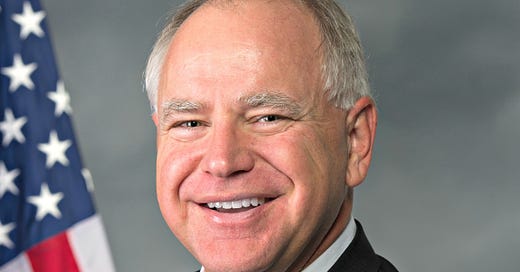Equity vs. Equal Protection: The Walz Approach
Does an identity-based law in Minnesota endanger black children?
Public Policy
EQUITY VS. EQUAL PROTECTION: THE WALZ APPROACH
Does an identity-based law in Minnesota endanger black children?
Dave Gilbert
If you’re curious about Tim Walz’s approach to social policy, look no further than the Minnesota African American Family Preservation and Child Welfare Disproportionality Act, which Walz signed into law in May of this year.
This legislation raises the bar for removing children with specific identities (described below) from abusive homes and placing them in foster care. Social services agencies must undertake “active efforts” to prevent out-of-home placement for these identified groups. These “active efforts” are defined as a “rigorous and concerted level of effort”—a standard that significantly surpasses the existing “reasonable efforts” requirement. Meanwhile, for children not covered by the law’s provisions (more below), the lower “reasonable efforts” standard will continue to apply. The idea behind these measures is that it is better for children to stay with their original family, even when that family is far from ideal, than it is for them to enter the state system of foster care. Black and brown children, to mention just two of the identity groups targeted by the law, are disproportionately likely to end up in foster care.
How are the law’s innovations justified? Initially, the bill targeted only black children. However, legal advisors cautioned that such a narrow focus would likely fail to meet equal protection standards. Consequently, the enacted version broadened its scope to include any “disproportionately represented child.” This term encompasses children whose race, culture, ethnicity, disability status, or low-income socioeconomic status is overrepresented in the child welfare system compared to their proportion in the state’s overall child population.
Supporters of the law view it as a crucial step in addressing longstanding disparities in the child welfare system. At the bill’s ceremonial signing, Lieutenant Governor Peggy Flanagan, a citizen of the White Earth Nation, expressed her enthusiasm for the legislation: “This is the way governments should work.… As a Native woman, this bill hit home. So I’m incredibly grateful for all of the folks behind me who helped us get here today.”
However, critics of the law argue that this disproportion-based approach may endanger some of Minnesota’s most vulnerable children. They point out that the law is designed to make it more difficult to remove black and other “disproportionately represented” children from potentially abusive or neglectful homes. Critics cite concerning statistics, such as black children making up 26.1% of all child-maltreatment deaths in Minnesota between January 2015 and April 2022, despite constituting only 11% of the state’s population. The concern here is that it is really not in the best interests of black children and others targeted by the law to be more likely to remain trapped in homes where they face abuse and possible death.
While these perspectives highlight important concerns about both the fair treatment and safety of minority children, it’s also crucial to question why all vulnerable children, regardless of race, ethnicity, or economic background, don’t receive the same level of protective consideration under Walz’s law. The current policy requires more diligence from the state for black children regardless of their economic status, while only extending this extra care to other racial groups if they are economically disadvantaged. This creates a situation in which a black child from a middle-class or wealthy family would receive more careful consideration than a white or Asian child in similar economic circumstances.
This disparity in treatment suggests that in Minnesota’s view, race alone may legitimately determine the level of effort the state puts into keeping a family together. Arguably, however, all other factors being equal, the state should no more direct extra resources towards investigating the conditions of black children simply because they are black than it should direct extra resources to white children. We might question whether Minnesota’s attempt to equalize the proportions of children from each identity group that wind up in foster care truly serves children’s best interests. The disparity in treatment required to achieve “equal outcomes” raises important questions about equal protection under the law.
Notice, for example, that a white or Asian child from an abusive home not at the bottom of the economic ladder can be removed and placed in foster care as long as “reasonable efforts” have been made to prevent out-of-home placement. However, a black child (or any child from the groups “protected” by the law) can’t be removed without more vigorous “active efforts.” Such a policy fails to consider that children of all races deserve equal consideration and care when it comes to such crucial decisions about their welfare and family situation.
Beyond these differential standards for removing a child from dangerous homes, the law goes further in its race-specific approach: it budgets millions of state tax dollars to create a race-specific African American Child Well-Being Advisory Council and an African American Child Well-Being Unit within the Department of Human Services. It is worth noting that such provisions, which appear to fly in the face of equal protection standards, are very much in keeping with Critical Race Theory (CRT), which seeks to “transform our entire legal system into one that privileges group rights over individual rights.” This raises the sort of question that every piece of CRT-inspired legislation raises, namely, if we look at endangered children as individuals, why should some of these individuals receive more consideration and resources than other individuals simply because of the accident of their skin color?
Walz is the future of the Democratic party. Democrats will continue to flood state legislatures with race-specific policy that rejects equal treatment, memorializes differential treatment, creates race-based councils and department units, and budgets public monies towards race-based programs, all in the service of “equity.” Critical Race Theory will gradually overtake all the case law that stands in the way. Depending on your perspective, this is either a good or bad development. But while Democrats occupy themselves with transforming our legal system and our legal codes to conform to their new vision of justice, who will be thinking, not of group outcomes, but of the children?
Dave Gilbert is a technologist and former visiting assistant professor of communication with interests at the intersection of technology, culture, and identity. Originally from rural Tennessee, he now lives in northern California with his photographer girlfriend and their four cats. Dave finds his greatest joy in bicycling through Big Sur and camping in the Mojave Desert. He is a founding member of Free Black Thought. He shares his views on X here.





Identity based thought is a disservice to everyone, every time it's applied. It buries the person, thereby burying the real issue, whatever it is. So, a political tool is sharpened, money is lavished and the victim/patient is ignored. Way to go. Another great Marxist policy.
While Tim is at it maybe he should insure that all races are proportionately represented in the state’s prison system by arresting and sentencing innocent white people. He surely has considered that approach.